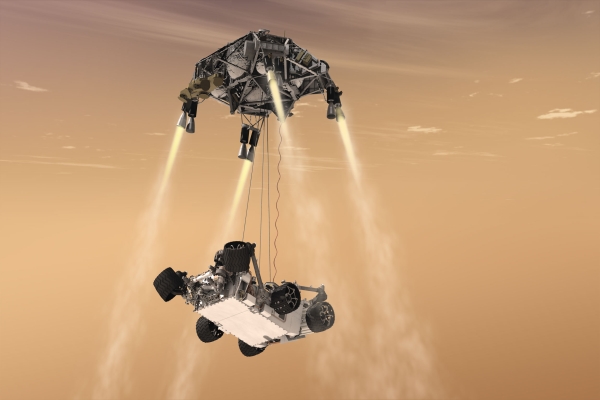Published on the 16/06/2016 | Written by Donovan Jackson

The out-of-this-world power of collaboration…
What does it take to put something heavy on Mars, the planet considered the most likely target for extra-terrestrial human colonisation? The answer is collaboration on a grand scale, with some 3760 people involved in the project to put a rover on the surface of our red neighbour. While it may not be a question to which most of us give too much thought, it was brought vividly to life recently by NASA engineer Adam Steltzner. Presenting at integration and intelligence software company Tibco’s recent conference in Las Vegas, he provided a fascinating glimpse into the effort involved and process followed by the space agency to put Curiosity to work far, far away. Steltzner started with a personal anecdote: as a young and somewhat directionless man, the stars above caught his gaze and imagination; that curiosity led him to sign up for a local astronomy course. “But before I could take it, it was cancelled,” he laughed. Despite that (and admitting a fear/loathing of mathematics and failing geometry at school) Steltzner went on to complete a PhD in engineering mechanics, no doubt an essential component in his ascendancy to the position of chief engineer on the Mars rover project (he is presently serving as chief engineer on the Mars 2020 project). A weighty challenge It is that enormous weight gain which posed the greatest difficulty for Steltzner and his team; while getting that mass off the ground here on Earth and across the vastness of the void to Mars might appear to be the heart of the challenge, that’s (relatively) easily solved by adding a bigger rocket. More difficult by far was the question of slowing it down for a gentle landing on the surface of a planet with a thin atmosphere. After all, 900 kilograms of highly sophisticated equipment plummeting into a big red ball at thousands of miles per hour would just leave a highly unsophisticated and entirely insignificantly small new crater on the alien landscape. “We had to make the seemingly impossible possible, by slowing down a ton of rover travelling at over 13,000 miles per hour [20,800 km/h] and land it gently,” said Steltzner. Getting crazy Crazy? So much so that Steltzner said the obvious response to first coming up with such a plan was to laugh it off. “But this was an extraordinary problem which required an extraordinary solution. The thing, however, is that crazy sometimes is just crazy. But the greatest innovations often, at the outset, look crazy too.” Just look at the pioneers of flight and indeed the parachute, which would find perhaps its ultimate expression in the descent to Mars; dispensing with dignity (and, frequently, life itself) was a prerequisite for these early pathfinders. “We don’t explore because it is practical, we do so because it is impractical. Early flight looked stupid, dangerous, uncomfortable and embarrassing. But they kept at it,” Steltzner noted. “We don’t explore because it is practical, we do so because it is impractical.” The right stuff Mad as the Curiosity landing plan was, it worked – and with the team being unsure of success until the actual descent over 500 million kilometres away, the description of that event as ‘seven minutes of terror’ is apt. Steltzner credits collaboration and curiosity itself for successfully putting Curiosity to work, where it has been in operation since 2014 with a now-indefinite mission duration. “The act of exploration is a personal one and it starts with curiosity. Inherent, native human curiosity is the most powerful tool to compete, innovative and achieve in the world,” he said. “Over 3700 people put curiosity on Mars; how did it go so well? Collaboration which underpins the ability to innovate and solve problems, and the ability to interact [with team members] aggressively intellectually.” … Where access and governance meet… Getting practical on building AI maturity… More than just cybersecurity… Asset-centric industries are ripe for an AI revolution, but without the hype… Are buyers looking for AI features? Or is the reverse more true?
Now, vigilant readers will appreciate that Curiosity isn’t the first vehicle to make the 560-odd million kilometre trip to the Red Planet. The big difference with Curiosity is its mass. This rover, bristling with scientific instruments, cameras and communications equipment, robotics, and a generation system which is expected to power it for a minimum of 14 years, weighs in at just under 900 kilograms. By comparison, preceding (2004) Mars rovers Opportunity and Spirit tilted the scales at a paltry 185 kilograms apiece.
It was this significant challenge which set his team to work to find an answer through collaboration and the willingness to countenance even the most ridiculous of suggested solutions. Ultimately, the solution came down to what the team dubbed the ‘Sky Crane’. Suitably outlandish, it involved the deployment of a supersonic parachute which would slow the plummeting ton, bringing it within range to fire booster rockets that would further retard the descent, then – perhaps the most bizarre component of all – the extension of the rover on cables to set it gently on the surface of the planet. Following this sequence, the ‘mother ship’ would cut the cables and boost itself to land neatly out of the way.
When Steltzner took the idea to NASA administrator Mike Griffin, he said, “It might just be the right kind of crazy.” (An affirmation which would become part of the title of Steltzner’s book.)FURTHER READING

Cyber resilience begins with modern identity security

Asset management leaders share AI insights

Identity security as a business transformer

Don’t run before you can walk with AI

The evolving role of AI in business technology



























